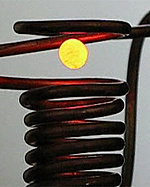For metallic melts electromagnetic levitation provides an elegant method of noncontact containerless measurement, eliminating most interactions between the sample and its environment. This technique has been used in the past mainly for the study of highly reactive melts at high-temperatures. The sample, assuming a simple spherical shape, is contained in a clean environment and can be studied over a large temperature range. Temperatures again have to be measured with a pyrometer. An electromagnetic levitation device employs inhomogeneous radio-frequency electromagnetic fields to heat and position the samples. Such a field has two effects on a conducting, diamagnetic body. First, it induces eddy currents within the material, which, due to ohmic losses, eventually heat up the sample by inductive heating, and second, it exerts a Lorentz force on the body, pushing it towards regions of lower field strength. The latter effect can be used to compensate the gravitational force.
A schematic display of the experimental technique and some main items of instrumentation for an electromagnetic levitation system are given in the figure. The details of the components vary for different measurements and for different techniques. The sample is levitated in a special designed high frequency coil, which is supplied by a RF – generator (100 kHz to 1 MHz). The levitation coil is usually water-cooled. The levitated sample is placed in a vacuum chamber with quartz windows for various types of optical diagnostics such as a fast CCD - camera to monitor the sample shape and thus obtain density or surface tension results, a pyrometer for temperature measurements, and a probe laser, which sometimes also can be used for heating. In the figure the laser is part of an ellipsometer device for the measurement of emissivities on the liquid sample. The ambient cooling-gas also has to be supplied to the experimental chamber.
